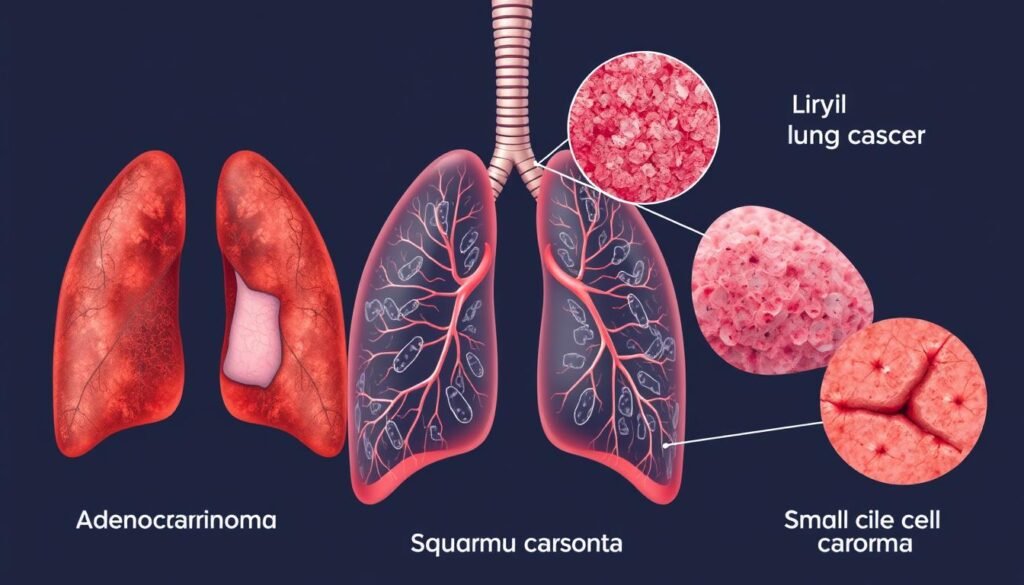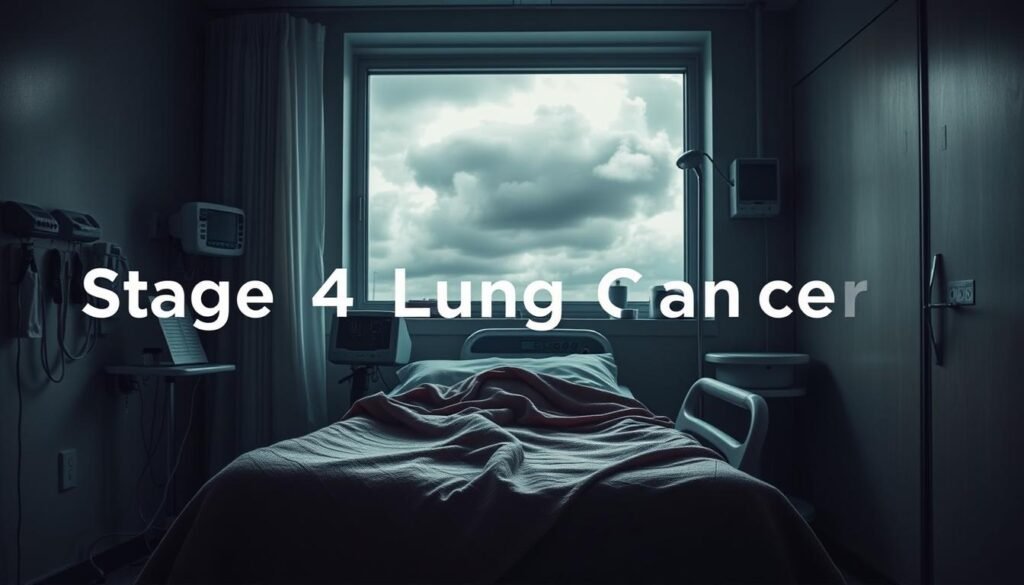Did you know that only 9% of people with Stage 4 non-small cell lung cancer survive five years after diagnosis? This statistic highlights how serious Stage 4 lung cancer is. It’s the last stage of the disease, often called terminal or end-stage lung cancer. At this point, the cancer has spread far beyond the lungs, reaching organs like the liver and brain.
This severe spread means treatment focuses on symptom management and improving life quality, not curing the disease. For patients and their families, knowing about this advanced cancer stage is crucial. It helps them deal with the emotional and practical challenges of such a diagnosis. To learn more about Stage 4 lung cancer, including what to expect and treatment options, click Stage 4 Lung Cancer Overview.
Key Takeaways
- Stage 4 is the most advanced, or worst stage of lung cancer, leading to a poor prognosis.
- The disease may spread to multiple distant organs, impacting treatment options.
- Survival rates at this stage are alarmingly low, with only 9% surviving five years.
- Palliative care is crucial for managing symptoms in patients dealing with advanced lung cancer.
- Awareness and understanding of Stage 4 can provide emotional support for patients and families.
- Different treatment approaches exist for Non-Small Cell Lung Cancer and Small Cell Lung Cancer.
Understanding Lung Cancer Staging
Staging is crucial in the fight against lung cancer. It helps doctors understand the cancer’s development and spread. Knowing the stage aids in choosing the best treatment and predicting the disease’s path.
What is Cancer Staging?
The TNM system is used to classify lung cancer. It looks at tumor size, lymph node involvement, and metastasis presence. Lung cancer is categorized into stages from 0 to IV. Stage 0 means the cancer hasn’t spread. As stages increase, so does the cancer’s severity and spread. Stage I cancer is still local, but Stage IV indicates it has reached distant organs.
Importance of Knowing the Stage of Lung Cancer
Understanding the lung cancer stage is key to effective treatment. It allows for personalized care strategies. This specificity is crucial in decision-making and might better outcomes. Knowing the stage helps patients and doctors choose treatments and foresee life quality impacts. Addressing lung cancer at various stages greatly influences the care and support given.
| Stage | Description | Metastasis |
|---|---|---|
| Stage 0 | Carcinoma in situ, localized | None |
| Stage I | Early localized cancer, not spread | None |
| Stage II | Larger tumors, may involve nearby nodes | None |
| Stage III | Locally advanced, may involve lymph nodes | None |
| Stage IV | Advanced cancer, may affect distant organs | Yes |
What is Stage 4 Lung Cancer?
Stage 4 lung cancer is the most serious level of this disease. It’s also called advanced lung cancer or metastatic lung cancer. This means the cancer has spread to both lungs or other parts of the body. Knowing about this stage is crucial for those with lung cancer and their families. It helps them understand their treatment options and what to expect.
Defining Advanced Lung Cancer
Advanced lung cancer is when the disease needs immediate treatment. It includes stages 4A and 4B. Stage 4A could be cancer spreading to outside the chest or one lung. Stage 4B means the cancer has spread more widely, even to distant organs. This information is important for planning the right treatment.
Differences Between Stage 4A and 4B
The differences between stage 4A and 4B affect how lung cancer is treated. Below is a table that compares these stages:
| Stage | Metastasis Location | Treatment Implications |
|---|---|---|
| Stage 4A | Single area outside the lung or to one lung | Possible local treatment with systemic therapy |
| Stage 4B | Multiple distant organs affected | Focus on systemic therapy; palliative care may be key |
Symptoms of Stage 4 Lung Cancer
Stage 4 lung cancer affects a patient’s life greatly. These symptoms of stage 4 lung cancer are crucial for doctors to treat this illness. They help patients and families get ready for what’s to come.
Common Signs and Symptoms
Many with stage 4 lung cancer have a cough that gets worse and won’t go away. They may also cough up blood. Other common symptoms include:
- Chest pain that gets worse when you breathe or cough
- Tiredness that sleep doesn’t fix
- Hard time breathing
- Losing weight without trying
- Not feeling hungry, leading to eating less
- Getting lung infections often
Knowing these signs is key for those with stage 4 lung cancer. It helps with choosing treatments and planning for care at the end of life.
Symptoms Related to Metastasis
When the cancer spreads, or metastasizes, it brings different metastatic cancer symptoms. Symptoms depend on where the cancer moves to. They can include:
- Headaches, which may mean the brain is affected
- Jaundice, suggesting the liver is involved
- Bone pain if it reaches the bones
- Seizures, if it spreads to the brain
These issues can make breathing difficulties worse. This needs close watching and care. Plus, emotional and mental support is key during this tough time. It’s hard to deal with these advanced symptoms.
Types of Lung Cancer at Stage 4
Stage 4 lung cancer comes in two main types: non-small cell lung cancer (NSCLC) and small cell lung cancer (SCLC). These types act differently and need different treatments. Knowing about these kinds at stage 4 is key for good care.
Non-Small Cell Lung Cancer (NSCLC)
NSCLC is more common, making up about 80-85% of lung cancer cases. At stage 4, NSCLC means the cancer has spread to other organs. This affects how long patients might live. The five-year survival rate for stage 4 lung cancer is very low, about 1%.
Treatments focus on helping with symptoms and making life better. They often don’t aim to cure the disease. Since NSCLC is advanced, patients might feel worse side effects. They need care that is understanding and supportive.
Small Cell Lung Cancer (SCLC)
SCLC is rarer, being about 10-15% of lung cancer cases. It grows fast and is more aggressive. This type is divided into limited and extensive stages. At the extensive stage, treatments aim to control the disease, not cure it. SCLC spreads quickly, making it hard to treat well. For patients at stage 4, finding expert care is very important.

Diagnosis of Stage 4 Lung Cancer
Doctors use many tests to diagnose stage 4 lung cancer. Getting the diagnosis right is very important. This helps doctors create the best treatment plan. Stage 4 lung cancer is advanced, so doctors need to be very accurate.
Diagnostic Tests Used
Doctors use several tests to figure out if someone has lung cancer and how far it has gone:
- Imaging Tests: CT scans and MRIs give clear images of the lungs. These help see the tumor’s size and if it has spread.
- Biopsies: This test takes tissue samples to check for cancer and what type it is.
- Positron Emission Tomography (PET) Scans: These scans can see if cancer has moved to other body parts.
The Importance of Accurate Staging
Correctly staging stage 4 lung cancer is vital for treatment. Wrong staging can lead to bad treatment choices. It can also make people miss out on good treatments. Doctors look at tumor size, if it has reached the lymph nodes, and if it has spread far. This info helps doctors make a personalized treatment plan.
They use the TNM system (Tumour, Node, Metastasis) to describe the cancer’s stage. This makes the cancer’s condition clear to everyone.
Worst Stage of Lung Cancer: Prognosis and Expectations
Stage 4 lung cancer marks the disease’s most advanced level. It comes with significantly lower chances of survival compared to earlier stages. For patients and their families, understanding what this means is key. It helps in making choices and preparing emotionally.
Survival Rates for Stage 4 Lung Cancer
The survival rates for stage 4 lung cancer are very low. Recent numbers show only 5 out of 100 people with non-small cell lung cancer live for five years after diagnosis. For small cell lung cancer, the rate is about 3%. These statistics underline the huge challenges for those diagnosed at this late stage.
Factors Influencing Prognosis
Many factors play a significant role in the outlook for stage 4 lung cancer patients. Important aspects include:
- Age: Younger people often fare better than older ones.
- Gender: Women may have a bit better outcomes than men.
- General health: Being healthy before cancer can mean a better prognosis.
- Performance status: Keeping up with daily life can boost survival chances.
- Genetic mutations: Some genetic changes help with treatment, improving survival.
Knowing these factors helps understand what to expect with stage 4 lung cancer. Although the outlook is not bright, being informed can assist families and patients as they face what’s ahead.

| Cancer Type | 5-Year Survival Rate |
|---|---|
| Non-Small Cell Lung Cancer | 5% |
| Small Cell Lung Cancer | 3% |
Treatment Options Available for Stage 4 Lung Cancer
Treatment for stage 4 lung cancer focuses on improving life quality and increasing survival time. Treatment choice depends on the lung cancer type: non-small cell (NSCLC) or small cell (SCLC). Patients are advised to work closely with their healthcare team. They can find a treatment plan that best matches their health status and cancer type.
Overview of Treatment Approaches
A range of treatments is available for stage 4 lung cancer. Three main options are commonly used:
- Chemotherapy: Usually combines drugs like cisplatin or carboplatin with gemcitabine, mainly for NSCLC. It can also be used as ongoing maintenance therapy.
- Targeted therapy: Targets specific genetic changes in cancer cells. For example, sotorasib (Lumakras) for KRAS G12C-positive NSCLC or dabrafenib (Tafinlar) with trametinib (Mekinist) for BRAF V600E mutant cases.
- Immunotherapy: Drugs like pembrolizumab (Keytruda) and atezolizumab (Tecentriq) activate the immune system. They help it fight the cancer more effectively.
Specific Treatments for NSCLC vs. SCLC
For non-small cell lung cancer, several treatments are used:
| Treatment Type | NSCLC | SCLC |
|---|---|---|
| Chemotherapy | Cisplatin or carboplatin with gemcitabine | Palliative chemotherapy; |
| Targeted Therapy | Sotorasib for KRAS G12C-positive | N/A |
| Immunotherapy | Pembrolizumab, nivolumab combined with ipilimumab | Pembrolizumab |
| Surgery | Possible in select cases | Rarely performed |
For SCLC, treatment usually involves comprehensive systemic methods due to its aggressive behavior. Palliative care also plays a vital role for both cancer types. Finding the most suitable treatment involves a detailed talk about all options available.
Palliative and Supportive Care for Stage 4 Lung Cancer
Palliative care is key in improving life quality for those with advanced lung cancer. It focuses on managing symptoms, offering emotional support, and providing pain relief. It is helpful at any illness stage, not just the end of life. Talking about palliative care early on can improve outcomes. Teams of doctors, nurses, and social workers meet the needs linked to lung cancer.
Understanding Palliative Care
Palliative care boosts patient wellness by tackling various troubling symptoms. People may face problems like:
- Pain
- Shortness of breath
- Fatigue
- Nausea
- Constipation
- Loss of appetite
- Sleep problems
- Anxiety
- Depression
Supportive care includes treatments to open airways and medication for pain and breathing. There’s also nutritional aid and integrative therapies like massage. Thus, patients can better manage their symptoms.
Choosing Hospice Care
Hospice care becomes critical as lung cancer advances, focusing on comfort. It aims to make the last life stages peaceful. Services include pain management, emotional support, and family help. Knowing when to choose hospice is vital for patients and their families. It ensures the needed gentle support during tough times.

| Type of Care | Description | Focus |
|---|---|---|
| Palliative Care | Symptom management and emotional support throughout the illness | Quality of life enhancement |
| Hospice Care | End-of-life comfort and support when curative treatment is no longer pursued | Maximizing peace and minimizing suffering |
Emotional and Psychological Impact of Stage 4 Lung Cancer
Being told you have Stage 4 lung cancer is very hard. It affects patients and their families deeply. Knowing how cancer affects your mind is key to dealing with its challenges. Feelings like fear, sadness, and worry come up often. That’s why getting emotional support is so important.
Managing Emotional Response to Diagnosis
After finding out they have cancer, patients feel many strong emotions. It’s important to deal with these feelings in a healthy way. Knowing the signs of anxiety and depression is the first step to getting better. Talking to a professional can help a lot. Activities like mindfulness and exercise also boost your mood. Ignoring these emotional issues can make life harder, so it’s crucial to tackle them head-on.
Support Groups and Counseling Options
Joining a support group can be very helpful for those with Stage 4 lung cancer. These groups give comfort, share experiences, and fight the feeling of being alone. Meeting others in the same boat can make you stronger. They offer advice on dealing with cancer and its emotional effects. Counseling is another way to deal with the tough feelings, helping to improve mental health a lot.
Role of Caregivers for Patients with Stage 4 Lung Cancer
Caregivers play a vital role for those with Stage 4 lung cancer. They handle medical tasks, give medication, and provide comfort. By doing so, they enhance the patient’s life and lessen their own stress.
Responsibilities of Caregivers
The tasks caregivers must tackle are many. They include:
- Helping with daily activities like bathing and eating
- Driving to doctor appointments and treatments
- Working with healthcare teams
- Being a source of emotional support
- Managing symptoms and pain
- Handling chores and preparing meals
- Talking through end-of-life plans
It’s critical for caregivers to look after their well-being too. Finding support helps them stay strong for their loved ones.
Resources for Caregivers
There are many resources for caregivers:
- Support groups provide a place to connect and share
- Online communities for advice and support
- Counseling to deal with stress
- Hotlines and local help for caregiving advice
- Guides on lung cancer care, like this link
Understanding caregivers’ challenges leads to better care. Caregivers should know the risks of anxiety and depression. A strong support network is crucial for overcoming caregiving challenges.
Supporting caregivers’ emotional and practical needs is essential. It assures the best care for those with Stage 4 lung cancer. This journey underscores community importance, shared stories, and using resources well.
| Caregiver Support | Benefits |
|---|---|
| Support Groups | Provide emotional support and reduce isolation |
| Online Communities | Access to resources and connection with other caregivers |
| Counseling Services | Assist in managing stress, anxiety, and depression |
| Informational Guides | Enhance understanding of cancer and caregiving tasks |
Conclusion
Stage 4 lung cancer is tough for patients and their families. It’s at this stage that health challenges increase and making decisions about treatments becomes crucial. There are treatments like chemotherapy and immunotherapy. They can help improve life and possibly extend it.
It’s also essential to consider the emotional side. Many patients feel very anxious or depressed. The reasons include their health state and symptoms. There are ways to help, such as counseling and support groups. They offer a space to talk and find ways to cope.
Everyone faces stage 4 lung cancer differently. Having a good support network helps a lot. This network should include caregivers, doctors, and various resources. With the right information and people to talk to, dealing with this condition becomes more manageable. This support can ease symptoms and help with the challenges they face.